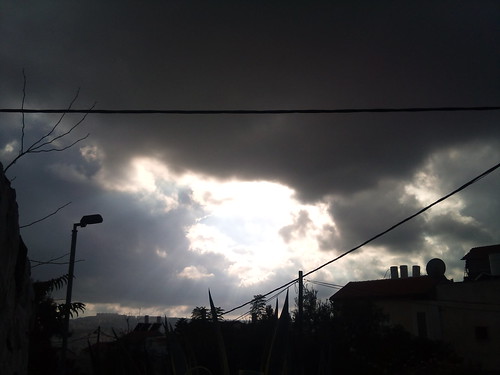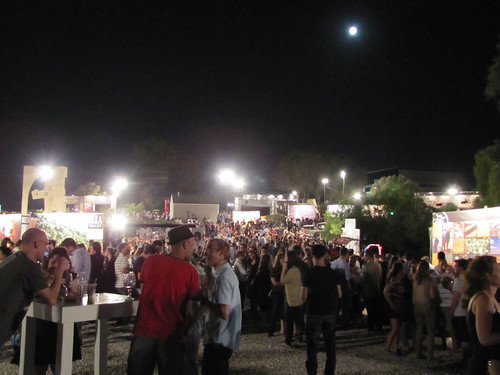Palm trees at twilight:

Drama in the sky:

Spidey on her web:

More photos after the jump.




I never had the honor of meeting Jean Craighead George, the well-known naturalist and writer, although we corresponded briefly after she published her book, The Cats of Roxville Station. She was a strong advocate of animal rescue, having raised hundreds of animals throughout her life.
Years ago, I was given a copy of her book, How to Talk to Your Cat. A slim volume, it is filled with anecdotes and scientific information not only about communication among cats and between cats and humans, but also about communication in the animal, bird and insect world.
The most striking story in the book – and one of my favorites – is about a cat named Danny, who belonged to Mrs. George’s friend. Here it is:
The cat Danny was not fed for the two days that my friend Joan Gordon was delayed out of town. He had a door through which he could come and go to his hunting grounds, where he often caught mice, and Joan was not overly concerned about him. He was, after all, a cat, capable and independent, the perfect predator. Joan had left him on his own before.
As she came up the path to the house, she smiled to hear Danny meowing his chirruping welcome. Eagerly she opened the door.
“Hello, Danny, old fellow. I’m glad to see you. Hello.” The hefty, ruddy tabby cat looked right at her face and chirruped again. His fur was pressed lightly to his body, his whiskers were bowed forward, his pupils were dilated with pleasure, his tail was held straight up like a flag pole, and he danced on his toes: an altogether exuberant greeting, perhaps best translated as “Hello, hello, hello, hello.”
But something amiss caught Joan’s attention. A kitchen chair had been knocked over, by Danny no doubt, and one leg had jammed his door closed. The cat had not eaten after all.
With great concern Joan dropped her coat and suitcase, opened a can of food, and put it on the floor.
But Danny did not eat.
Hungry as he must have been, he ran to Joan and repeated the redundant greeting. Next he rubbed Joan’s ankles with his head, then with his flank, and then snaked his tail over her shins, all the while purring. He arched his back toward her hand, asking to be petted. She obliged and then again urged food on him.
Danny ignored the food and went on with his cat talk. He rose on his hind legs and arched his shoulders and neck toward Joan’s hand, asking more forcefully this time to be petted again. When Joan stroked him, he purred like a motorcycle. Finally Danny turned to the food, only to take one bite and return to repeat the entire exuberant, sensual, deeply felt, and minutes-long “Welcome-home” routine again.
Joan called me that night, incredulous. Danny, she now knew, put her before a can of food.
Here is Mrs. George’s biography, from her website. Here is a tribute to her that ran in the New York Times.
Rest in peace, Mrs. George. Thank you for sharing your love of animals, and your knowledge of them – gathered over almost a century – with us.
As I was heading home from work last Tuesday evening, a wave of dizziness hit me so hard that I clutched the wall of a building for support.
When I recovered, I looked around surreptitiously, terribly embarrassed. Had anybody seen me do that? I sincerely hoped not. I didn’t want anyone to think I was drunk.
And then I felt it. I can’t really describe it, but it’s the feeling I’ve come to recognize as my temperature going up... and up... and up.
I wonder what the thermometer’s going to tell me when I get home, I thought to myself.
What it told me was 102.1 degrees Fahrenheit.
Wonderful.
I emailed in sick to work and went straight to bed, hoping that a night and a day of solid rest would do the trick.
No such luck.
My doctor doesn’t have office hours on Wednesdays. So by late Wednesday afternoon, when I realized I needed medical attention, my dear friend and neighbor, N., went with me to the local branch of Terem, the emergency clinic.
The waiting room was empty when we arrived. I barely had time to get settled in my seat when I was called for the intake process.
After various tests, including a whole blood count, and an examination by one of the physicians on duty, I was given my diagnosis: viral infection. The treatment: painkillers to keep the fever down.
N. and I went to the nearby pharmacy, where I bought the meds. Then we went home, and I went to bed... but not to sleep.
Weird images kept popping through my head. A recent project kept popping up on a screen in my mind. Words and headings and HTML code jumbled in front of my eyes as I tried to sort them out, then watched helplessly as the job grew exponentially. Under other circumstances, it might have been amusing, even entertaining. Here, it was just more stress... and true sleep never came that night.
I got some sleep the next day and tried to eat. I say “tried” because I realized that my body just didn’t want food. In fact, the thought of food made my gorge rise just a little. But I forced myself to eat and drink, knowing that if I didn’t, I would just get worse.
And get worse I did. By the next evening – Thursday – N. and I were back at Terem, where I got an infusion of fluids.
Back home a few hours later, I had another sleepless night.
In the morning, I finally read the information sheet that came with the pain meds I had been given... and the list of possible side effects was ghastly. And guess what – they included “vision or hearing disturbances; seeing/hearing strange things.”
Great.
Friday was a little better. N. picked up some oranges and lemons for me so that I could make homemade drinks to keep up my electrolytes. (Recipes on request.) I made a few, got them down and felt much better.
On Shabbat, I drank much more than I ate. And I rested. Boy, did I rest. My friend L. came to visit me, and N. and I spent time together, too. At one point, I asked N. if I could sample some of her cola (in a separate glass, of course!). I hardly ever drink cola – but this time, when I did, my foggy brain seemed to clear. Coincidence or caffeine?
Then she offered me a small ice-cream pop. I hardly ever eat ice-cream pops, even though I am fond of them, but this time I decided to say yes. It was delicious.
So my body was starting to accept food without a struggle, and my brain was clearing – both good signs.
So what’s going on now? I still have a fever, but it’s much lower than it was, and I feel better than I’ve felt in days.
Here’s hoping for continued improvement.
But I’m still curious: what on earth is this bug?
And when is it finally going to go away?
One of the characters in Chaucer’s Canterbury Tales is the Pardoner, a corrupt, low-level cleric who goes around selling pardons, indulgences and fake relics to credulous believers. He begins his tale by exposing the tricks of his trade – how he gets his customers, anxious to buy their way out of perdition, to cough up their cash for his bogus wares. After he finishes his tale, he launches into his spiel, either out of hutzpah or total stupidity, since he’s just admitted to his hearers that he’s a fraud. The Host retorts: That’s enough! Do you think we were born yesterday? If you thought you could get away with it, you’d have us kissing your dirty underwear as a saint’s relic, too!
I thought of the Pardoner late last week when I got a phone call from an unidentified number. Usually, I don’t answer phone calls from unidentified numbers, but this time I did.
When I heard a pause on the line and a bit of static, I thought that this might be an overseas call with a bit of delay. So I waited, and after a second or so, I heard a click, and then a recorded message began.
A male voice – the voice of an actor, of course – told a story of how his life had been going well, and then his luck had suddenly taken a turn for the worse. His business began to suffer, his finances dwindled, his home lost its peace and tranquility and his health declined. Then he found out about a marvelous remedy and decided to try it: prayers offered by a tzaddik (Hebrew: “righteous person”) on his behalf at a particular holy site. Once the tzaddik prayed for him, his good fortune was restored just like the old joke about the country song played backwards: his business recovered, his prosperity returned, his family relationships improved and his health problems vanished.
Although I didn’t buy the spiel for a moment, I wanted to see where it would lead. So I stayed on the line and obeyed the actor’s exhortation to “Press 1” if I wanted to see similar salvation in my life.
I was connected to an operator at a call center, a young woman who read me an additional little spiel telling me how much it would cost to buy this salvation: more than three hundred shekels. I had no intention of buying in. I simply wanted to say my piece. I told her my concerns and asked to speak to the manager. She gave me a number to call.
I called the number and soon was on the line with the manager, an older-sounding woman with a friendly, professional phone manner.
“I’m a religious woman,” I told her, “and I felt I had to tell you how disturbed I was by this phone call. It’s such an obvious fake. Anyone could tell that the speaker in the recorded message is an actor reading from a script.
“As a religious person, I find this whole thing disgusting. It’s nothing but a cheap scare tactic – a marketing gimmick of the worst kind. Luckily, I have some background in Judaism, and I know that isn’t what Judaism is about. I was always taught that one of Judaism’s basic teachings, and one of the things that makes it different from other faiths, is the belief that every person can approach God on his or her own, without an intermediary. On top of that, the message is a prepared script being read by someone who is obviously a hired actor, but you’re trying to pass it off as real. This insults people’s intelligence. If I were a secular Israeli with little background in Judaism, it would turn me right off. I would say to myself: ‘If this is what Judaism is, I want no part of it.’ Is this the image we want to present? Is this what we want people to think Judaism is?”
The manager answered: “Our target audience is secular and traditional people, not necessarily religious people. We really do send tzaddikim to the holy site to pray for the people who donate, and the money goes to needy families. We can prove it. And Judaism does teach that the prayers of tzaddikim are more effective than those of an ordinary person.”
“I don’t agree,” I said. “That’s not a basic teaching of Judaism, and anyway the idea of the tzaddik came much later. There are plenty of scholars and teachers who disagree with it.”
“We just had two women call us up to tell us that the prayers really helped them,” the woman said. “You’re the only one who thinks there’s anything wrong with what we’re doing. We’re helping the needy. Don’t you think that’s a worthy goal?”
“I’m glad if the women were helped,” I said, “and helping the needy is always a worthy goal. As for being the only one who thinks you’re going about it the wrong way, I’m not sure about that. It’s entirely possible that other people think so, too. I’m just the only one so far who’s taken the time to call you and tell you about it.”
I could have asked more questions then, such as who decides how the funds are distributed and what percentage of the collected funds actually reaches the needy families. But I didn’t have the time to pursue it. Instead, I asked: “How did you get my number?”
She named my long-distance provider. “They sell us their subscriber list, and we go on from there,” she said.
I thanked her, and the conversation ended on a good note.
Once I hung up, I got the urge to call my long-distance provider, tell them to stop selling my phone number to spammers and threaten to cancel my subscription if I ever got another spam call. But then I found myself wondering something else. Maybe this whole thing had nothing to do with offering prayers on behalf of people looking for relief from life’s vicissitudes or helping the needy. Could it be that all this was nothing but a devilishly clever ploy to lure customers away from that particular long-distance company?
Dignity personified:
An instant later: dignity? What on earth is that?
Kitten loves him a good tummyrub:
My faithful assistant when I work at home:
And for good measure, here is Her Ladyship doing her impression of a da Vinci cat:
Here are some scenes from my commute to work these days:
Grapes on the vine:
Old railway cars, photographed from the bus heading homeward:
Gradations of green and brown, just where the hills leading to Jerusalem begin along the route:


This song, “Landmarks,” is the title track from Yehoram Gaon’s eponymous album, released in 1982. The words and music are by Naomi Shemer. Even though my translation doesn’t hold a candle to Shemer’s exquisite original, I felt that if I could bring even a tiny bit of the beauty of this song to English-speakers, it would be worth the attempt.
Does anyone remember, does anyone know
the way to my home?
Let anyone who hears my voice
come home with me.
There are feathery clouds above
and stubble at my feet,
and the pealing of the magical bell
that always watches over me.
(Refrain:)
Somewhere out there, along the road,
somewhere out there sings a bell.
From somewhere out there, it tells me: Return home
at the right time.
In case I have forgotten the way
that I knew for so many years,
Here and there, at the side of the road,
landmarks have been left for me.
Here is an arrow pointing outward,
drawn in white chalk, as if to say:
Go, follow the wind
starting two and a quarter paces from here.
Somewhere out there, along the road,
somewhere out there sings a bell.
From somewhere out there, it tells me: Return home
at the right time.
At the roadside is a quarry
shaded by a tree,
and a well or two
as a sign and a landmark for me.
A nanny goat, black as night,
browses among the bushes.
Trails like these
are only for the strongest hikers.
Somewhere out there, along the road,
somewhere out there sings a bell.
From somewhere out there, it tells me: Return home
at the right time.
I am not alone on the road
that leads to my home.
One or two friends
are walking home with me.
And in the light of the sun, as it sets
to the sound of pealing bells,
They will be able to read
all the landmarks for me.
Somewhere out there, along the road,
somewhere out there sings a bell.
From somewhere out there, it tells me: Return home
at the right time,
the right time.
Not fifteen minutes ago, I heard the way you browbeat your son in public. I wasn’t the only one. The whole street heard it. I’m sure none of us wanted to. But we couldn’t help it – you were so loud, so strident, so angry... at your young son. And you went on for so very long. And for what? The way you were yelling at him, we might have thought that he’d surrendered Jerusalem to the enemy in wartime, God forbid.
“Where’s your tzitzis? Where’d you get that sweatshirt? Did you get it from A.? Answer me! You’re lying! Don’t you lie to me!”
Let me get this straight. You were berating your son in public – a serious offense in Jewish law – over a sweatshirt that he presumably borrowed from a friend? Over a pair of missing tzitzit that cost just a few shekels to replace?
Sir, I saw the car you were driving when you stopped by the side of the road to scold and browbeat your son. Since it was dark, I didn’t catch the exact make and model – but it looked to be a pretty new, and fancy, mid-size family van. And with New York license plates, too, so if you are the owner of the car, you must be pretty well off to be able to own a van like that and ship it overseas. And there you were, sitting in the driver’s seat, screaming at your child who was on foot, humiliating him in front of dozens of people, shouting at him for minutes on end, so loudly that the entire street could hear you, over – let me get this straight – a sweatshirt and a set of tzitzit?
But it wasn’t only that. You didn’t just yell at your son for a few moments and then stop. You went on and on and on for minutes on end, not even giving the kid a chance to explain, or to get a word in edgewise. On and on you went with your repeated accusations and questions, your shouting, your cruel, chilling tone of voice.
Yes, sir, that was me you saw heading toward your car. Actually, I don’t know whether you saw me or not. I don’t know whether you suddenly recollected that you were in public, that you had just done a very ugly thing – a hillul ha-Shem, in fact – and were suddenly ashamed and drove away, or perhaps you had simply finished your tirade and drove off in a huff, leaving your son walking on the sidewalk in the opposite direction.
I wasn’t going to yell at you, sir. I promise. I had no intention of stooping to the level that you had just stooped to in front of who-knows-how-many dozens of people. All I intended to do was quote you, Mr. Religious Jew, Psalm 130, verse 3, which most religious Jews know by heart:
אם-עוונות תשמור, י-ה ה', מי יעמוד?
If You kept a record of sins, O Lord, who could stand?
... and then ask you how you had the hutzpah – the nerve – to ask God for mercy in your prayers after the way you had just treated your son.
I had wanted to put up this post for Yom ha-Atzma’ut, but things got rather hectic. So here it is now.
The Caravan Song, an optimistic look at Israel’s immigrant roots and rebirth, appears on the joint album by Arik Einstein and Miki Gavrielov, Al Gevul ha-Or (On the Verge of Light, 1987).
This song contains several references to contemporary Israeli history and culture: the historical longing for Israel, the pioneers who drained the swamps, the refugees who came from Europe and Arab lands. The song mentions Kibbutz Degania in the north and Dimona, a development town in the Negev, in the same line.
Listeners familiar with Israeli history and culture will also pick out the first line of the Palmach anthem, Me-saviv yehom ha-sa’ar (Though the storm howl all around us).
And the old man who, the song promises, will be kept happy? He is none other than David Ben-Gurion himself, who felt so strongly about settling the Negev that he retired there with his wife Paula after leaving political life.
Another possible reference: “They won’t go on without us” could be a nod to another song on this album that achieved iconic status: Sa Le’at (Drive Slowly). (The line there is “They won’t start without us.”)
The Caravan Song
Lyrics: Eli Mohar
Music: Greek folk tune
Performed by Arik Einstein and Miki Gavrielov
We spoke languages without number
And hardly knew one another.
We left a great many places
For the only one we loved and longed for.
We left a great many places
And came here, to Israel.
And the caravan goes on
From the previous century.
The first arrivals are history now:
Farmers and pioneers
Who did tough, back-breaking work,
Never knowing where it would lead.
Now it is our turn,
And we have not been idle.
They won’t go on without us.
This is the adventure of our lives.
We slipped out of ghettos and camps
And came to swamps and wasteland.
From the furthest ends of Arabia, Russia and Poland,
We lit lamps in Dimona and Degania.
From the furthest ends of Arabia, Russia and Poland,
We lit lamps in Dimona and Degania.
From all the countries of the Diaspora,
Despite all the problems,
A nation was created and a country arose,
And a language that had lain dormant
Awoke to life once more
And keeps on talking and talking.
“Though the storm howl all around us”
And difficulties and sorrow abound,
There is still reason to rejoice:
We have plenty of courage and strength.
Look how Israel thrives all around us:
It is stronger than all our shortcomings.
[Elderly man:] And the Negev will bloom one day, too!
[Lead vocalist:] And we’ll be sure to make the Old Man happy.
The Negev will bloom one day, too,
And we’ll be sure to make the Old Man happy.
From all the countries of the Diaspora,
Despite all the problems,
A nation was created and a country arose,
And a language that had lain dormant
Awoke to life once more
And keeps on talking and talking.
“Though the storm howl all around us”
And difficulties and sorrow abound,
There is still reason to rejoice:
We have plenty of courage and strength.
And the caravan goes on
From the previous century.
The first arrivals are history now:
Farmers and pioneers
Who did tough, back-breaking work,
Never knowing where it would lead.
Now it is our turn,
And we have not been idle.
They won’t go on without us.
This is the adventure of our lives.
Upon the highway a tree once stood –
stood listing, leaning earthward.
Sleep, child, sleep. Night is falling,
A stormy night upon the water.
Hush, child. The ship pitches sideways,
listing in the raging wind.
Upon the highway a tree once stood,
with neither bud nor apple on it.
It was to this tree, my son,
that your mother’s father used to go
as the evening shadows nested in the tree
and nothing stirred.
Your mother’s father would lean his head against it,
facing toward Jerusalem.
Weeping, he would recite the afternoon prayer
to his God, just the two of them.
To that same tree, my son, your father
was tied, bound with cords.
They beat him with iron rods and whips, my son,
as hot breath like steam ascended.
When the whip, sharper than a knife,
had become red as fire,
your father sank silent to the ground,
at the time of the afternoon prayer, as evening fell.
Slowly he sank from his altar,
his face turned toward Jerusalem.
Hush, child. The ship lists to the side,
pitches, kisses the water.
The ship pitches sideways,
and rises, claw extended!
Upon the highway a tree was cut down –
cut down to become the mast of a ship!
Hush, child. The gate of glorious fame
will open before that mast.
Today it, too, is a pillar of prayer;
today it, too, is an altar.
Upon the highway stood a tree
that will never fall to the ground.
Sleep, child. The ship lists to the side,
sails onward, cleaving water.




The last of Laurence Simon’s original four cats, Nardo, the Mighty Stripey Hunter and star of the catcams back in the day, has passed on.
Years ago, I enjoyed watching Nardo on the catcams, together with Laurence and Gina’s other three cats, Piper, Edloe and Frisky. I loved watching them all – Piper doing Kitty Yoga, Edloe being her fuzzy, Grumpus self, and Frisky chasing rainbows (Frisky sightings were good luck) – but there was something special about Nardo. (Maybe I just have a soft spot in my heart for orange cats.)
Now the four of them are reunited on the Other Side. Rest well, Nardo... and may there be plenty of toys for you to find and hide there.
To Laurence and Gina, my condolences. May you be consoled in the knowledge that you gave Nardo a good life filled with love and care, and find comfort in your memories of him.
May you find comfort, too, in the presence of the baby panthers, Bruwyn and Myst.
These two articles – one from Lehigh Valley’s The Morning Call about the inhuman working conditions at the Amazon warehouse and the other from Mother Jones about similar conditions at an unidentified warehouse – made me think of an analogy that may seem over the top, darkly humorous or cheeky at first: the Inquisition. But I’m not joking. Here’s why.
Being a Church institution, the Inquisition could not sully itself with something as mundane as bloodshed. (Its officials had no problem subjecting innocent human beings to unspeakable torture, but actual executions? How gauche.) So they came up with a legal fiction: instead of condemning their victims to death outright, they would simply “relax” them – turn them over to the Inquisition’s “secular arm” with a pious injunction to “shed no blood”... wink, wink, nudge, nudge.
In other words, the Inquisition outsourced its executions, and used that very outsourcing to evade responsibility for them.
That is the analogy that came into my mind when I read this sentence: “Temporary-staffing agencies keep the stink of unacceptable labor conditions off the companies whose names you know.”
It’s only a blurb at the bottom of the second page of the article in Mother Jones, but that’s what it made me think of.
Apart from the Inquisition... the victims of the Triangle Shirtwaist Fire of 1911 must be turning in their graves. In the US of 2012, the sweatshops are back.
Here are some photos that I took today.
A rose hip:
A ladybug:
Pods with seeds:
White blossoms on a succulent:
A bee on a blossom. It looks to me almost as though the bee were driving a vehicle, holding a tiny steering wheel:
Finally, a mystery fruit. I’ve been wondering for ages what it is. Anyone? Anyone? Bueller? Botanist?
When I flipped the calendar page last week from January to February, I realized – in addition to all the other things I have planned for this month – that it was time for my annual mammography.
Yes, that’s right – the big squeeze.
So off I headed to the doc, got my referral – and then, since I happened to be in the area later that day, I stopped in personally at the Hala Clinic to make the appointment. Luckily for me, there was a vacant slot the very next day!
Although I got there on time, I had to wait before being seen; the clinic is very busy. But I didn’t mind. There was good reading material in the waiting room, so I picked up a book and got comfortable. Also, I had fair warning – the woman who made my appointment told me that it might take as long as three hours from start to finish.
When my turn came, the technician escorted me to the examining room. There I was... umm... examined. Squeezed between two plastic trays with curved ends, one of which moved. Squished, squashed, temporarily turned into a pancake – however you want to describe it. But even as I tried to obey the technician’s instructions to relax, turn my head this way, hold my arm that way, breathe, and defy gravity while standing on my head and whistling “Dixie,” I focused on how grateful I was to live in a time and place where there’s access to early detection and treatment.
Then I returned to the waiting room to be summoned for the physical exam and ultrasound. A few minutes on the exam table and it was done. (They even warmed the ultrasound jelly! Pardon the expression, but how cool is that?!)
The best part – besides the clean bill of health (tfu, tfu, tfu) – was that I was in and out of the clinic in just over an hour!
So where’s the public service announcement in all this? Here it is: Ladies, go get checked! Yes, it takes time from your busy schedules. True, it’s not the most fun thing in the world. But it’s really, truly, very important. So pick up the phone and make an appointment for your Big Squeeze today!
When I was in a train station in Tel Aviv recently, I stopped at a stall where books intended for religious audiences were being sold. One of the books was a guide for women about how to tie kerchiefs.
Curious, I decided to take a look... and was shocked to see that in every illustration, the woman’s face had been digitally altered. The backgrounds were real, the clothing was real, but the women’s faces were not. Apparently it is now considered unseemly to show even the face of a woman in a photograph. It must be digitally altered or blurred in order to be acceptable.
Here are two examples:
I will say again what I have been saying for years about the increasing strictures on the visibility of women in Jewish society here: it is not about modesty and has never been. It is about turf, power, control and entitlement. It is about one group of people forcing their restrictive view of Judaism on others, halakhic scholarship be damned (or, at the very least, severely distorted). It is unbalanced, unhealthy, dangerous and very frightening.